
















Ancient Board Games
and Solitaire Games
From Around the World
Copyright © 2008,2010 by Robert Wayne Atkins, P.E.
All Rights Reserved.
All the games on this webpage, plus a lot more, are included in my book Ancient Board Games and Solitaire Games From Around the World, Combined Volumes One and Two.
During hard times it is very easy to become depressed and melancholy. If you allow yourself to fall into this type of mood then it will quickly spread to the other members of your household. During hard times you and your family will need to have some form of entertainment to help take your minds off the depressing situations that exist all around you.

During hard times money is usually very limited, or simply not available. This means no electricity and no television or Game Boys.
Fortunately, children are very good at entertaining themselves. They will play tag, or hide-and-go-seek. These games do not cost anything and they are not dependent on electricity. However, these types of games are relatively noisy, and they do consume a lot of human energy (calories). With limited food resources it would probably be better if your children could entertain themselves in a less active, less noisy manner. This would also provide them with a change of pace so they could switch from a game that requires physical skills to a game that requires intellectual skills, such as board games.
Some board games require an investment in the game itself, such as Monopoly, or Life, or Candy Land. If you already have these types of board games then you will probably discover that your children will be playing them more frequently when there is no electricity.
However, children enjoy variety. Therefore it would probably be a good idea if you knew how to construct some very entertaining board games that require no special construction skills, effort, or materials. You would simply need to know how to put the game together, and you would need to know the rules for playing the game. The games that are discussed below fit into this category of board games. Some of them have been around for several thousand years. But most of them have been forgotten because most game manufacturers prefer to produce and sell their own copyrighted games since they yield a higher profit margin than a public domain game.
The games which are discussed below have game boards that may easily be drawn on a piece of white paper using a ruler and a ink pen. Once drawn, you can save the game board and use it many, many times until it eventually wears out. If you are on a camping expedition then the game board could simply be drawn in the dirt on the ground.
The playing pieces could be white and dark buttons, or pennies and nickels, or colored golf tees, or small different colored rocks. Or you could use the 16 pawns (8 black and 8 white) from a game of Chess. If you need more than 16 game pieces then you could use the pawns from several games of Chess purchased for $1.00 each at a "Dollar Tree" store.
By using these very simple items you would be able to create a nice variety of board games for your children. And once your children learn how easy it is to make the game board and the game pieces, then they will be able to do this simple construction activity themselves anytime and anywhere they wish to play. However, I suggest that you play these games with your children on a periodic basis to help your family bond together and to reinforce the fact that you find these games to be intellectually stimulating and challenging. Children are usually much more eager to play "adult" type games than purely children games. Although all of the following games are deceptively simple in appearance, and have a minimum of rules, and are easy to learn how to play, each game also has a unique set of multiple strategies for offense and defense. If you do not intentionally let your children win too often, then your children will learn that there is more to the game than they currently understand and they will try to figure out your strategy for winning the game. This will help them to become better problem solvers later in their own lives.
Before discussing the actual games themselves, please allow me to also suggest that you purchase a nice deck of 52 plastic coated playing cards. An ordinary deck of 52 playing cards can be used to play hundreds of card games and solitaire games, including Hearts, Spades, Rummy, Bridge, Go Fish, War, and Old Maid (after you temporarily remove three of the queens from the deck). A simple deck of playing cards will help your children recognize and understand the meaning of the numbers two through ten, because each card has the same number of symbols as the printed number on the card. And a simple two-dollar investment in a quality deck of 52 playing cards will provide hundreds of hours of entertainment each year for one person, or for two people, or for your entire family. The cheaper playing cards are usually not plastic coated, which means they have a tendency to stick together, and they more easily acquire stains and rough edges and bent corners. Therefore I personally would prefer to have one quality deck of plastic coated playing cards than two cheap decks because the quality deck of cards will easily outlast two cheap decks of playing cards. If you have young children and you can afford it, then you should probably invest in a few spare decks of plastic coated playing cards for future years because young children can easily wear out a deck of good cards in one year. However, two dollars is a cheap investment if it keeps your children quietly occupied for a few hundred hours each year. (Note: I personally prefer a deck of cards with a generic back design as opposed to a design that includes nude figures, such as the Bicycle brand, or gambling symbols or gambling words.)
Finally, if you have young children, then you should also consider reading stories to them. This activity will help to bond your family together and it will help to pass the time and keep your children quite, inactive, and entertained while you are reading. It will also help to motivate your children to learn how to read, and it will assist them in this educational process because they will be not only be looking at the color storybook pictures but they will also be looking at the letters and words on the pages as you read. It is much, much easier to learn how to read well if the material you are reading is entertaining to you. Children love to hear the same story again, and again, and again. Children don't become bored with the story the same way an adult does. Please keep this in mind when your children beg you to read the same story that you just read to them a few minutes ago. May I suggest the following two children's story books. Both books are reasonably priced, they contain beautiful full-color pictures, and they will require very little space and effort to take with you if you are forced to relocate as a result of the current hard times.
- Walt Disney's Story Land: 55 Favorite Stories, and
- The Children's Treasury: Best Loved Stories and Poems From Around the World.
List of Board Games In Order of Difficulty
With Complete Playing Instructions
Some of the games that are described below have been around for several thousand years, and they have been played by individuals in many different parts of the world who speak a variety of different languages. Because of the translation issues with specific words in different languages, the games do sometimes have slightly different rules depending on which continent the game is being played. The instructions which appear below are the most commonly agreed upon rules for each individual game. However, some of the games do have interesting variations, and when appropriate, those variations are also described.
Basic Game Rules
Most historical game instructions refer to the color of the game pieces as dark and light pieces, or as black and white pieces. However, over the centuries many different ancient game boards have been discovered. These game boards sometimes have playing pieces of beautiful colors, instead of black and white. Therefore, there is no valid reason to believe that the game pieces must be black and white for the game to be played in its correct traditional historical manner. As long as the game pieces of each player can be easily distinguished from the game pieces of the other player, then any colors may be used for the game pieces.
When the game pieces are not equally divided among the players, such as in the games "Fox and Geese" and "Hnefatafl" and "Go", then there is a valid reason why one of the players should go first. However, when the game board is perfectly symmetrical, and each player has exactly the same number of games pieces in exactly the same mirrored locations, then there is no valid reason to insist that one color must always play first. This decision can be further complicated if the game pieces are uniquely and beautifully made, and they are not black and white. Therefore, in the game instructions which follow, the players are given the option to determine who goes first, except in those circumstances as noted above.
Which Player Gets Each Color and
Which Player Goes First?
Unless a game has a definite rule about which player goes first, then the following method will give each player an equal chance of:
- playing either color, and
- making the first move.
Which Color? One player takes one piece of each color in each hand and switches the pieces behind his or her back several times so the other player cannot see what is happening. The first player then brings both hands forward with a game piece in each closed hand so the color of the game piece cannot be seen. The second player then selects one hand and whatever color is in that hand will be the second player's color.
Who Goes First? The second player then takes both pieces from the first player and repeats the mixing procedure. The second player then offers two closed hands to the first player, with a game piece in each closed hand out of sight. The first player then selects a closed hand, and whatever color is in that hand is the color that goes first.
If the game is played more than one time, then the players should take turns: (1) switching colors and, (2) letting the other player go first.
Achi
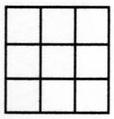 Name of Game: Achi
Name of Game: Achi
Origin of Game: Africa
Players: 2
Pieces: One player has four dark color pieces. The other player has four light color pieces. (Note: Any two different colors may be used.)
Board Design: A three by three square, for a total of nine positions.
Objective: The first player to line up three pieces in a straight line in any direction wins (horizontal, vertical, or diagonal).
How to Play:
Either player may go first. On future games the players should take turns going first.
The players take turns placing one of their four original pieces on any open position on the board. After both players have placed all four of their pieces on the board, the players take turns moving one of their own pieces into the one open position on the board. A piece may only be moved one space at a time, either horizontally, vertically, or diagonally. A piece may not jump another piece.
Winning: The first player to line up three of his or her own pieces in a straight line in any direction wins.
Alternate Version of the Game Achi:
Picaria: Before 1600 A.D. - Played by the Pueblo Indians in New Mexico, United States.
Each player only has three pieces instead of four. All the other rules are the same.
Horseshoe
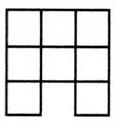 Name of Game: Horseshoe
Name of Game: Horseshoe
Origin of Game: China (An ancient Chinese strategy game.)
Players: 2
Pieces: One player has three dark color pieces. The other player has three light color pieces. (Note: Any two different colors may be used.)
Board Design: A three by three horseshoe, for a total of eight positions.
Objective: To block the other player's pieces so he or she cannot make a move.
How to Play:
Either player may go first. On future games the players should take turns going first.
The players take turns placing one of their three original pieces on any open position on the board. After both players have placed all three of their pieces on the board, the players take turns moving one of his or her own pieces into any open position on the board. A piece may only be moved one space at a time, either horizontally, vertically, or diagonally. A piece may not jump another piece. A piece cannot be moved into the open square at the bottom of the horseshoe game board.
Winning: The first player to block the other player so he or she cannot move is the winner.
Fox and Geese
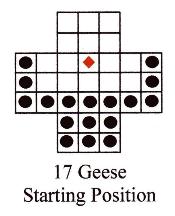
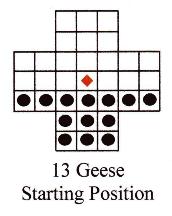 Name of Game: Fox and Geese
Name of Game: Fox and Geese
Origin of Game: Iceland, before 1300 A.D.
Players: 2
Pieces: 1 Fox (red or other color piece), 13 or 17 Geese (black or any color other than the Fox).
Board Design: A seven by seven cross, for a total of thirty-three positions.
Board Setup: The game board is always set up in one of the illustrated starting positions, depending on the total number of Geese.
Objective: The Geese attempt to trap the Fox so the Fox cannot move, while the Fox tries to eliminate most or all the Geese.
How to Play:
Either player may be the Fox. However, the next time the game is played the other player should be the Fox.
The Fox moves first. The Fox may move one space in any direction, horizontally or vertically, forwards or backwards, or right or left. Diagonal moves are not allowed. The Fox may jump over one of the Geese if there is an open space for the Fox to land on. If the Fox jumps one of the Geese, it is removed from the game board. The Fox may jump several Geese in one move, one at a time, as long as there is an open space for the Fox to land on after each jump. All the jumped Geese are removed from the game board.
The Geese move one space per turn in any direction, horizontally or vertically, forwards or backwards, or right or left. Diagonal moves are not permitted. The Geese cannot jump. The Geese try to surround the Fox in such a way that the Fox is backed into a corner and cannot move.
Winning:
If the Fox cannot move, then the Geese win.
When there are only three or fewer Geese left, then the Fox wins.

Ovid's Game
Name of Game: Ovid's Game.
Origin of Game: Before 8 AD (Jesus was a boy).
Players: 2
Pieces: One player has three dark color pieces. The other player has three light color pieces. (Note: Any two different colors may be used.)
Board Design: A three by three square, for a total of nine circles.
Objective: The first player to line up three pieces in a straight line in any direction wins (horizontal or vertical along the lines connecting any three circles).
How to Play:
Either player may go first. On future games the players should take turns going first.
The players take turns placing one of their three original pieces on any open circle on the board. If a player forms a straight line of three pieces then the player wins. Otherwise, after both players have placed all three of their pieces on the board, the players take turns moving one of their own pieces into one of the open circles on the board. A piece may only be moved one space at a time, either horizontally or vertically. A piece may not jump another piece. Movement must be along one of the straight lines connecting the circles.
Winning: The first player to line up three of his or her own pieces along any straight line connecting three circles wins.
Version One: No diagonal moves are allowed.
Version Two: Diagonal moves are only allowed through the center circle. Winning may occur in a straight line through the center circle.
Version Three: Diagonal moves are allowed through the center circle and across the straight lines connecting the circles on the outside of the square. Winning the game must still be done in a single straight line that connects three circles and not through a bent line that connects three circles.
Tac Tix
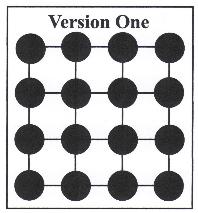
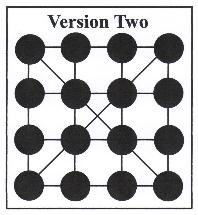
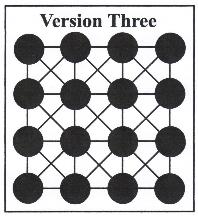
Name of Game: Tac Tix.
Origin of Game: Created in the 1940’s by Piet Hein, Copenhagen, Denmark.
Players: 2
Pieces: 16 game pieces of any color.
Board Design: A four by four square, for a total of sixteen circles.
Board Setup: A game piece is placed inside every one of the circles before the game begins.
Objective: To force the other player to take the last game piece from the game board.
How to Play:
Either player may go first. On future games the players should take turns going first.
Players take turns removing one, two, three, or four adjacent game pieces along any straight line. Game pieces are adjacent if there is no open circle between them. If an open circle is between two pieces, then the pieces are not adjacent. A player may remove as many adjacent pieces as he or she chooses and he or she does not have to remove all the adjacent pieces in a straight line. However, a player may not remove a game piece and then skip a game piece and then remove the next game piece.
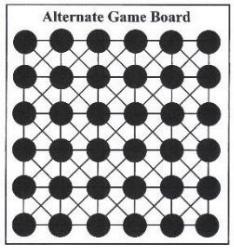 Winning: Whichever player takes the last game piece from the game board loses and the other player wins.
Winning: Whichever player takes the last game piece from the game board loses and the other player wins.
Version One: No diagonal lines connect any circles and all moves must be either horizontal or vertical.
Version Two: Diagonal lines connect the four corners and moves may also be along the straight diagonal lines connecting the corner circles.
Version Three: Horizontal, vertical, and diagonal lines connect the circles in all directions and moves may be along any straight line that connects the circles.
Alternate Board Design: A six by six square, for a total of thirty-six circles, and 36 game pieces. All the game rules are the same as Version Three above but the game board is now larger and there are more options to consider.
Four Field Kono
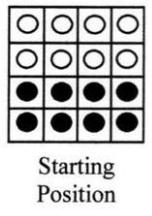 Name of Game: Four Field Kono
Name of Game: Four Field Kono
Origin of Game: Korea
Players: 2
Pieces: One player has eight dark color pieces. The other player has eight light color pieces. (Note: Any two different colors may be used.)
Board Design: A four by four square, for a total of sixteen positions.
Objective: To capture as many of the other player's pieces as possible.
How to Play:
The game board is always set up in the illustrated starting position.
Either player may go first. On future games the players should take turns going first.
To capture an opponent's piece, you must jump over one of your own pieces and land on the space currently occupied by one of your opponent's pieces. Your opponent's piece is considered captured and it is removed from the board and your piece takes its place. Capture moves can be made either horizontally or vertically, but not diagonally. Multiple jumps or captures are not permitted. Only one piece may be captured per move.
If a capture is not possible, then the player may move one of his or her pieces one space horizontally or vertically, but not diagonally. A piece may be moved forwards or backwards, or right or left.
Winning: When your opponent is blocked and cannot move, or when your opponent only has one piece left, then you win.
Mu Torere
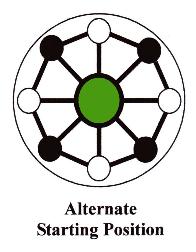
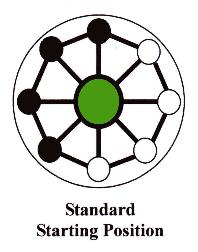 Name of Game: Mu Torere
Name of Game: Mu Torere
Origin of Game: New Zealand
Players: 2
Pieces: One player has 4 dark color pieces. The other player has 4 light color pieces. (Note: Any two different colors may be used.)
Board Design: A circle at each point of an octagon, and another circle in the center, for a total of nine circles.
Objective: To block the other player so he or she cannot make a move.
How to Play: The game board is always set up in the illustrated starting position, with each player's four pieces on his or her side of the game board. The center circle is empty.
Either player may go first. On future games the players should take turns going first.
There are only three legitimate moves along the solid lines as follows:
1. A piece may only be moved into the center circle if it is next to one of the other player's pieces.
2. A piece may be moved out of the center circle to any open circle.
3. A piece may be moved to any open circle next to it on the outside ring.
Winning: If a player cannot make a legitimate move, then the player is blocked and the other player wins.
Alternate Starting Position:
Alternate the color of the pieces on the outside circle instead of grouping them together. In other words, dark, light, dark, light, dark, light, dark, light.
The other playing rules remain the same.
El-Quirkat or Alquerque
 Name of Game: El-Quirkat (Arabia), Alquerque (Spain)
Name of Game: El-Quirkat (Arabia), Alquerque (Spain)
Origin of Game: Arabia, before 1400 B.C.
Players: 2
Pieces: One player has twelve dark color pieces. The other player has twelve light color pieces. (Note: Any two different colors may be used.)
Board Design: A five by five square, for a total of twenty-five positions.
Objective: To capture as many of the other player's pieces as possible.
How to Play:
The game board is always set up in the illustrated starting position. The center square is the only empty square at the beginning of the game.
Either player may go first. On future games the players should take turns going first.
Each player then takes a turn moving one of his or her pieces. A piece may be moved one space horizontally, or vertically, or diagonally, including forwards and backwards. A player cannot jump over one of his or her own pieces.
The objective is to jump over and capture your opponent's pieces, horizontally, vertically, or diagonally. You can jump more than one piece on your move as long as you jump your opponent's pieces one at a time and there is an open space to land on at the end of each of your jumps. On multiple jumps, the next jump does not have to be in a straight line with the first jump. The jumped pieces are captured and they are removed from the game board.
Winning: When both players have taken seven moves each, and no jumping or capturing has taken place, then the game is over. The player who has captured the most pieces wins.
Seega
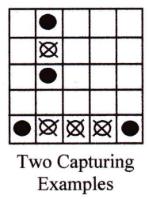 Name of Game: Seega
Name of Game: Seega
Origin of Game: Egypt, before 1324 B.C. - This game had been traced back to the time of the Egyptian Pharaoh Tutankhamen.
Players: 2
Pieces: One player has twelve dark color pieces. The other player has twelve light color pieces. (Note: Any two different colors may be used.)
Board Design: A five by five square, for a total of twenty-five positions.
Alternate Board Design: A seven by seven square, and each player has 24 playing pieces.
Objective: To capture as many of the other player's pieces as possible.
How to Play:
Either player may go first in Stage One. The other player goes first in Stage Two.
Stage One: The players take turns placing two of their twelve original pieces on any open position on the board, except a player may not place a piece on the square in the exact center of the board. After all twenty-four pieces have been placed on the game board, the center square will be the only empty position. Capturing does not begin until after all 24 pieces have been placed on the game board. Any pieces that are in a trapped position when the 24th piece is placed on the board are not considered trapped or captured pieces.
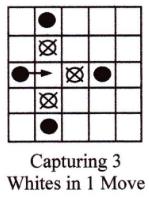 Stage Two: Each player then takes a turn moving one of his or her pieces. A piece may be moved one space forwards, backwards, right, or left, but not diagonally. A piece may not jump another piece.
Stage Two: Each player then takes a turn moving one of his or her pieces. A piece may be moved one space forwards, backwards, right, or left, but not diagonally. A piece may not jump another piece.
The objective is to trap one or more of your opponent's pieces between two of your pieces in either a horizontal or vertical row, but not a diagonal row. When a piece (or pieces) is trapped it is removed from the game board.
In the first two capturing examples, all of the white pieces have been successfully trapped by the dark colored pieces, and the white pieces should now be removed from the game board. In the third capturing example, the 3 white pieces are all trapped by the one move made by the dark piece. All 3 white pieces should now be removed from the game board.
The only way to trap and capture an opponent's piece is when it is your move. You can safely move one of your pieces between two of your opponent's pieces and your piece will not be considered trapped since it was your move.
If you cannot move then you lose your turn. Your opponent must then make a move that will permit you to move on your next turn.
Winning: When both players have taken seven moves each, and no trapping or capturing has taken place, then the game is over. The player who has captured the most pieces wins.
Derrah
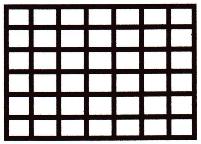 Name of Game: Derrah
Name of Game: Derrah
Origin of Game: Nigeria, Africa
Players: 2
Pieces: One player has 12 dark color pieces. The other player has 12 light color pieces. (Note: Any two colors may be used.)
Board Design: A grid of six rows and seven columns, for a total of forty-two positions.
Objective: To take ten of your opponent's playing pieces.
How to Play:
Either player may go first in Stage One. The other player goes first in Stage Two.
Stage One: The players take turns placing one of their twelve original pieces on any open position on the board. If a player makes a row of three pieces either horizontally or vertically, he or she gets to take any one of the other player's pieces off the game board, except a piece cannot be removed from a row of three. Any piece that is in a row of three is safe from being taken.
Stage Two: Each player then takes a turn moving one of his or her pieces. A piece may be moved one space horizontally or vertically, but not diagonally. A piece may move forwards or backwards, or left or right. A piece may not jump another piece. The objective during Stage Two is to line up three of your own pieces in a straight line either horizontally or vertically, but not diagonally. Each time a player makes a row of three the player takes any one of the other player's pieces off the game board, except a piece cannot be removed from a row of three. Any piece that is in a row of three is safe from being taken.
Winning: The first player to take ten of the other player's pieces is the winner.
Chinese Checkers
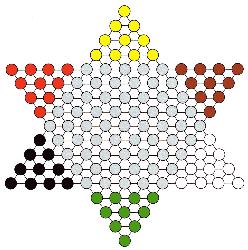 Name of Game: Chinese Checkers
Name of Game: Chinese Checkers
Origin of Game: Invented by Dr. George Howard Monks, Boston, Massachusetts, United States, 1883 or 1884. He originally called the game "Halma."
Players: 2, 3, 4, or 6.
Pieces: Each player has 10 pieces of a unique color.
Board Design: A six point star with ten pieces of a unique color in each point of the star.
Objective: To move all 10 of your pieces into the star triangle exactly opposite your original starting position.
How to Play:
Two players start in any two opposite points of the star.
Three players start across from an empty star point.
Four players start in two pairs of opposite star points.
Six players each begin in one of the six star points.
Choose to see which player goes first. Players take turns going around the board to the left of the starting player.
Moves: A piece may move along any line connecting any two adjacent circles. Or a piece may jump another piece as long as there is an empty circle on the board for the piece to land on. A player may jump one of his or her own pieces or another player's piece. Multiple jumps are allowed if there is an empty circle between each of the jumped pieces. Jumps do not have to be in a straight line. Jumped pieces remain on the board.
When a piece reaches the star triangle exactly opposite its original starting position, the piece may jump over any piece in that triangle, or the piece has the option to switch places with another player's piece inside that triangle.
Winning: The first player to move all ten of his or her pieces into the star triangle exactly opposite the player's original starting position wins the game.
Checkers or Draughts
 Name of Game: Checkers or Draughts
Name of Game: Checkers or Draughts
Players: 2
Origin: France, around 1100 A.D. (An 8x8 Checkerboard with 12 Pieces per Player.)
Pieces: One player has 12 dark color pieces. The other player has 12 light color pieces.
Objective: To capture all the other player's game pieces, or to block the other player.
How to Play: The game board is always set up in the illustrated starting position with a red square always on each player's left lower corner of the board. The game is only played on the red squares. Black moves first (tradition). The players take turns moving one of their checkers one square diagonally towards the other player's side of the board. A single checker cannot move or jump backwards. When a player diagonally jumps over one of the other player's checkers into an empty square then that checker is captured and removed from the board. Multiple jumps are allowed if there is an empty square diagonally on the other side of each jumped checker. If a jump is possible, it must be taken. If a checker reaches the opposite side of the board it becomes a king and another checker of the same color is placed on top of it (the crown) using one of the previously captured checkers. The king can then move diagonally forwards or backwards one square at a time.
Winning: The first player to capture all 12 of the other player's checkers, or to block the other player so the other player cannot make a move, wins the game. A tie game is also possible.
Five Other Games That May Be Played on a
Standard Checkerboard Using the Standard Checker Pieces
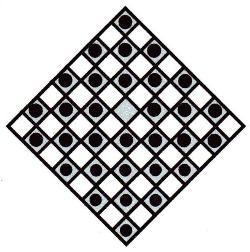
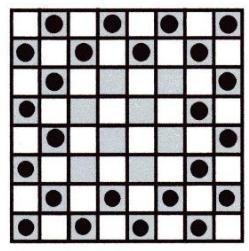 Name of Game: Checker Solitaire: Either Square or Diamond.
Name of Game: Checker Solitaire: Either Square or Diamond.
Players: 1
Pieces: Either 24 pieces (square) or 31 pieces (diamond). The pieces may be all the same color or they may be several different colors.
Board Design: An eight by eight checkerboard.
Objective: To jump as many pieces as possible and leave the fewest pieces on the game board.
How to Play: The board is always set up in one of the two illustrated starting positions: either in its normal square orientation (24 pieces) or rotated 45 degrees into a diamond configuration (31 pieces). The game is only played on the dark (or red) squares of the checkerboard. A piece may only move if it can jump another piece on an adjacent red square. There must be an open square to land on beyond the piece being jumped. The jumped piece is removed from the game board.
Winning: When no more jumps are possible the game is over. Determine your score as follows:
6 or more = Novice Player.
5 = Amateur Player.
4 = Beginner Player.
3 = Average Player.
2 = Advanced Player.
1 = Expert Player.
 Name of Game: Diamond Chinese Checkers
Name of Game: Diamond Chinese Checkers
Players: 2
Pieces: One player has ten dark color pieces. The other player has ten light color pieces.
Board Design: An eight by eight checkerboard rotated 45 degrees.
Objective: To move all your pieces across the board to the other player's original starting position.
How to Play: The game board is always set up in the illustrated starting position. The game is played on all the squares of the checkerboard regardless of color. Either player may go first. The players take turns. A piece may only move one space to an adjacent square of a different color.
A piece may also jump another piece that rests on a different color square, and then land on an open square the same color as its starting position. A player may jump his or her own pieces or the other player's pieces, one piece at a time. Multiple jumps are permitted if there is an open square in between each of the pieces being jumped. Multiple jumps do not have to be in a straight line. Jumped pieces are not removed from the board.
Winning: The first player to move all his or her pieces to the other player's starting position wins.
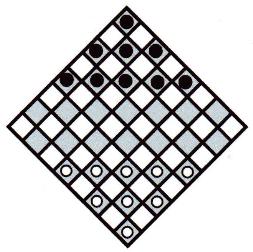 Name of Game: Triangular Checkers
Name of Game: Triangular Checkers
Players: 2
Pieces: One player has nine dark color pieces. The other player has nine light color pieces.
Board Design: An eight by eight checkerboard rotated 45 degrees.
Objective: To capture all the other player's game pieces, or to block the other player.
How to Play: The game board is always set up in the illustrated starting position. The game is only played on the red squares. Black moves first. The players take turns moving one of their checkers one red square towards the other player's side of the board, either forward or left or right. A single checker may not be moved backward towards its original starting corner. If the player can jump over one of the other player's checkers then that checker is captured and removed from the board. Multiple jumps are allowed if there is an empty square on the other side of each jumped checker. If a jump is possible, it must be taken. If a checker reaches the one dark (red) square in the opposite corner on the other player's side of the board it becomes a king and another checker of the same color is placed on top of it (the crown) using one of the previously captured checkers. The king can then move one red square forwards or backwards or left or right.
Winning: The first player to capture all 9 of the other player's checkers, or to block the other player so the other player cannot make a move, wins the game. A tie game is also possible.
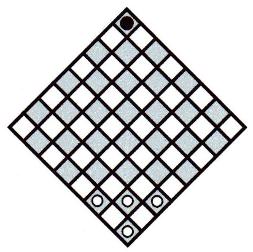 Name of Game: The Fox and the Hounds
Name of Game: The Fox and the Hounds
Players: 2
Pieces: One Fox, which is a dark color piece. Four Hounds, which are light color pieces.
Board Design: An eight by eight checkerboard rotated 45 degrees.
Objective: The Fox tries to get past the Hounds. The Hounds try to trap the Fox so it cannot move.
How to Play: The game board is always set up in the illustrated starting position. The game is only played on the dark (or red) squares of the checker board. No jumping is allowed.
Either player may be the Fox. However, the next time the game is played the other player should be the Fox. The Fox always goes first. The Fox may move one red square forward towards the Hounds original starting corner, or left, or right, or backward towards its original starting corner.
A Hound may move one red square forward towards the original starting position of the Fox, or left, or right. A Hound may not retreat backwards in the direction of its starting corner.
Winning: If the Fox can get past the Hounds so the Fox could move to the Hounds original starting corner, then the Fox wins. If the Hounds can trap the Fox so the Fox cannot move, then the Hounds win.
Nine Men's Morris
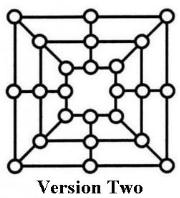
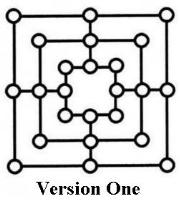 Name of Game: Nine Men's Morris (Version One)
Name of Game: Nine Men's Morris (Version One)
Origin of Game: Egypt, before 1400 B.C. - Game boards have been found carved in ancient Egyptian Temples, and carved on the decks of Viking Ships, and carved onto bench seats in Westminster Abbey in England.
Players: 2
Pieces: One player has nine dark color pieces. The other player has nine light color pieces. (Note: Any two different colors may be used.)
Board Design: Twenty-four connected circles as shown in the illustration.
Objective: To take seven of your opponent's playing pieces.
How to Play:
Either player may go first in Stage One. The other player goes first in Stage Two.
Stage One: The players take turns placing one of their nine original pieces on any open position on the board. If a player makes a row of three pieces either horizontally or vertically, he or she gets to take any one of the other player's pieces off the game board, except a piece cannot be removed from a row of three. Any piece that is in a row of three is safe from being taken.
Stage Two: Each player then takes a turn moving one of his or her pieces. A piece may be moved along any line to an adjacent open circle on the game board. A piece may not jump another piece. The objective during Stage Two is to line up three of your own pieces in a straight line. Each time a player makes a row of three the player takes any one of the other player's pieces off the game board, except a piece cannot be removed from a row of three. Any piece that is in a row of three is safe from being taken. A player may not skip a turn. A player must move one of his playing pieces each time it is his turn even if it means he will lose a playing piece on the next turn.
Strategy: After you have formed a three piece row, you can move one of your pieces out of the row. Then on your next turn you can move your piece back into the row and take another of your opponent's pieces off the game board. The ultimate strategy is to form two rows beside each other using five pieces, so each time you move a piece out of one row of three you form another row of three and you get to remove another of your opponent's playing pieces from the board.
Winning: The first player to take seven of the other player's pieces is the winner.
Nine Men's Morris (Version Two):
Version Two of this game is very similar to Version One except the corner circles are now connected with diagonal lines. The playing pieces may now move along these diagonal lines. Rows of three may also be formed along these diagonal lines. All the other games rules remain exactly the same.
Gomoku
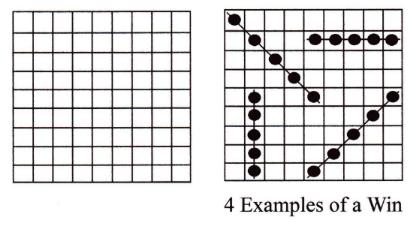 Name of Game: Gomoku
Name of Game: Gomoku
Origin of Game: Japan, during Heian Period (794-1185 A.D.)
Players: 2
Pieces: One player has 30 dark color pieces. The other player has 30 light color pieces. (Note: Any two different colors may be used.)
Board Design: A nine by nine square, for a total of eighty-one positions.
Objective: To form a straight line horizontally, vertically, or diagonally of five consecutive pieces.
How to Play:
Either player may go first in Stage One. The other player goes first in Stage Two.
Stage One: The players take turns placing one of their thirty original pieces on any open position on the board.
Stage Two: Each player then takes a turn moving one of his or her pieces. A piece may be moved one space horizontally or vertically, but not diagonally. A piece may not jump another piece. No pieces are captured or removed from the game board.
Winning: The first player to line up five of his or her own pieces in a straight line in any direction wins (horizontally, vertically, or diagonally). The game may be won during Stage One or Stage Two.
Dai Hasami Shogi
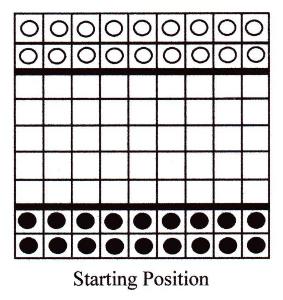 Name of Game: Dai Hasami Shogi (Dai means “double,” Hasami means “sandwiching,” Shogi means “9 by 9 board.”)
Name of Game: Dai Hasami Shogi (Dai means “double,” Hasami means “sandwiching,” Shogi means “9 by 9 board.”)
Origin of Game: Japan
Players: 2
Pieces: One player has 18 dark color pieces. The other player has 18 light color pieces. (Note: Any two different colors may be used.)
Board Design: A nine by nine square, for a total of eighty-one positions.
Objective: To form a straight line horizontally, vertically, or diagonally of five consecutive pieces in the center area of the game board between the two dark solid lines.
How to Play:
The game board is always set up in the illustrated starting position. All 18 pieces of each player are behind the dark solid lines on the player's side of the board.
Either player may go first. On future games the players should take turns going first.
The players take turns moving one of their pieces in either of the following two ways:
Option One: A player may move a piece any number of empty spaces either horizontally or vertically, either forwards or backwards, or left or right. A piece may not be moved diagonally. A piece may not cross the dark solid line on the opponent's side of the game board.
Option Two: A player may jump over one of his opponent's pieces if there is an empty space to land on. The jump may be horizontal or vertical, but it cannot be diagonal. Only one of the opponent's pieces can be jumped at one time. The opponent's piece is not captured and it remains on the game board.
A player cannot move over open spaces and jump over an opponent's piece in the same move.
After a piece has been moved into the center area of the game board between the two dark solid lines that piece must remain in the center area of the game board.
Winning: The first player to line up five of his or her playing pieces in a straight line horizontally, vertically, or diagonally in the center of the game board between the two dark solid lines wins the game.
Alternate Version of the Game Dai Hasami Shogi:
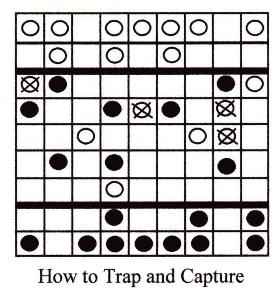 The starting position and the movement rules remain the same.
The starting position and the movement rules remain the same.
However, in this version it is possible to trap and capture one or more of your opponent's pieces between two of your pieces in either a horizontal or vertical row, but not a diagonal row. All the trapping pieces and the captured pieces must be within the two dark solid lines. When a piece (or pieces) is trapped it is removed from the game board.
In the trapping and capturing examples on the right, all the white pieces that are marked with an “X” have been successfully trapped by the dark colored pieces, and those white pieces should be removed from the game board when they are captured. The white pieces in the center playing area between the two dark solid lines that do not have an “X” are not trapped and they will remain on the board.
The only way to trap and capture an opponent's piece is when it is your move. You can safely move one of your pieces between two of your opponent's pieces and your piece will not be considered trapped since it was your move.
Winning:
There are two ways to win in this version of the game:
1. The first player to line up five of his or her playing pieces in a straight line horizontally, vertically, or diagonally in the center of the game board between the two dark solid lines wins the game.
2. The first player to capture 14 or more of the other player's pieces wins. The reason is because your opponent now has four or fewer pieces remaining and therefore your opponent no longer has the minimum five pieces required to win the game by arranging them in a straight line.
Petteia
Name of Game: Petteia.
 Origin of Game: Ancient Greece, before 360 B.C. - Later called Single Stone Latrunculi by the Romans.
Origin of Game: Ancient Greece, before 360 B.C. - Later called Single Stone Latrunculi by the Romans.
Players: 2
Pieces: One player has 12 dark color pieces. The other player has 12 light color pieces.
Board Design: A twelve by eight rectangle, for a total of ninety-six positions.
Alternate Board Design: An eight by eight square, and each player has 8 playing pieces.
Objective: To capture or trap the other player's pieces.
How to Play:
The game board is always set up in the illustrated starting position.
Either player may go first. On future games the players should take turns going first.
The players take turns moving their game pieces. A piece may be moved in a straight line any number of empty spaces forwards, backwards, right, or left. Diagonal moves are not permitted. A game piece may not jump over another game piece.
The objective is to capture one or more of your opponent's pieces between two of your pieces in either a horizontal or vertical row, but not a diagonal row. When a piece (or pieces) is captured it is removed from the game board. Pieces must be captured between game pieces of the other color. The walls and corners cannot be used to capture a piece, but they can be used to surround and trap a piece so it cannot move.
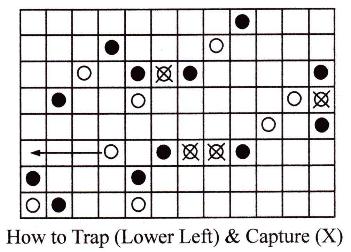 In the illustration, each white piece with an “X” mark has been captured and it should be removed from the game board. The white piece in the lower left corner of the board is now “trapped” and it cannot move. However, it was not “captured” so it remains on the game board. White could free the trapped piece by moving the white piece in the direction of the arrow and capturing the black piece.
In the illustration, each white piece with an “X” mark has been captured and it should be removed from the game board. The white piece in the lower left corner of the board is now “trapped” and it cannot move. However, it was not “captured” so it remains on the game board. White could free the trapped piece by moving the white piece in the direction of the arrow and capturing the black piece.
The only way to capture an opponent's piece is when it is your move. You can safely move one of your pieces between two of your opponent's pieces and your piece will not be considered captured since it was your move.
Winning: There are three ways a player can win the game:
- The first player to reduce his opponent down to one game piece, or no game pieces, wins.
- The first player to trap all the other player's pieces so the other player cannot move wins the game.
- When both players have taken twelve moves each, and no capturing or trapping has taken place, then the game is over. At the end of the game any pieces that are still trapped are considered captured and they are added into the final total of captured pieces. The player who has captured the most pieces wins.
Latrunculi - Version One
Name of Game: Latrunculi - Version One, with 24 Soldiers per Player.
Origin of Game: Ancient Rome, before 27 B.C. - Also known as Ludus Latrunculorum, which means “The Game of Soldiers.”
Players: 2
Pieces: One player has 24 dark color pieces, which are called soldiers. The other player has 24 light color pieces.
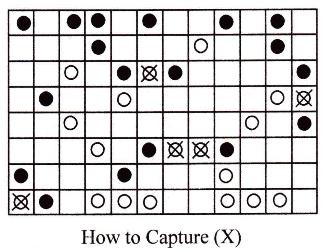 Board Design: A twelve by eight rectangle, for a total of ninety-six positions.
Board Design: A twelve by eight rectangle, for a total of ninety-six positions.
Alternate Board Design: An eight by eight square, and each player has 16 playing pieces.
Objective: To capture the other player's pieces.
How to Play:
Either player may go first in Stage One. The other player goes first in Stage Two.
Stage One: The players take turns placing two of their 24 original pieces on any open position on the board. Only one piece may occupy a square. Capturing does not begin until after all 48 pieces have been placed on the game board. Any pieces that are in a trapped position when the 48th piece is placed on the board are not considered trapped or captured pieces.
Stage Two: Each player then takes a turn moving one of his or her pieces. A piece may be moved one space forwards, backwards, right, or left. Diagonal moves are not permitted. A piece may not jump another piece.
The objective is to capture one or more of your opponent's pieces between two of your pieces in either a horizontal or vertical row, but not a diagonal row. When a piece (or pieces) is captured it is removed from the game board. Pieces must be captured between game pieces of the other color. In the illustration, each white piece with an “X” mark been captured and it should be removed from the game board.
The only way to capture an opponent's piece is when it is your move. You can safely move one of your pieces between two of your opponent's pieces and your piece will not be considered captured since it was your move.
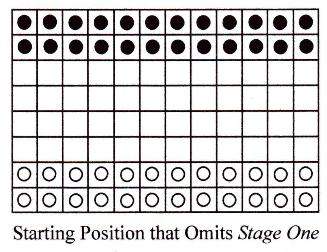 Winning: There are two ways a player can win the game:
Winning: There are two ways a player can win the game:
- The first player to reduce his opponent down to one game piece, or no game pieces, wins.
- When both players have taken twelve moves each, and no capturing has taken place, then the game is over. The player who has captured the most pieces wins.
Alternate Starting Position: All the pieces are arranged as shown in the illustrated Starting Position and there is no Stage One of the game.
Latrunculi - Version Two
Name of Game: Latrunculi - Version Two, with 12 Soldiers and 1 King per Player.
Origin of Game: Ancient Rome, before 27 B.C.
Players: 2
Pieces: One player has 12 round dark color pieces, which are called soldiers, and 1 king of a different shape than the soldiers. The other player has 12 light color soldiers and 1 king.
(Note: The king can be the same shape as the other pieces but it should be much taller.)
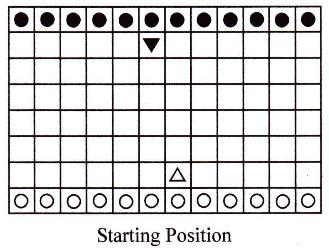 Board Design: A twelve by eight rectangle, for a total of ninety-six positions.
Board Design: A twelve by eight rectangle, for a total of ninety-six positions.
Objective: To capture all the other player's soldiers, or to trap the other player's king.
How to Play:
The game board is always set up in the illustrated starting position. The brave triangular king is always placed in front of his twelve round soldiers. The kings are not directly opposite one another at the start.
Either player may go first. On future games the players should take turns going first.
The players take turns moving their game pieces. A player may move one of his or her pieces, either a soldier or a king, in a straight line any number of empty spaces forwards, backwards, right, or left. Diagonal moves are not permitted. A game piece may not jump another game piece.
The objective is to capture one or more of your opponent's soldiers between two of your pieces in either a horizontal or vertical row, but not a diagonal row. When a soldier (or soldiers) is captured it is removed from the game board. Soldiers must be captured between game pieces of the other color, either by two soldiers or by the king working with one of his soldiers.
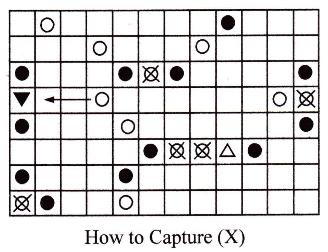 In the illustration, each white soldier with an “X” mark has been captured and it should be removed from the game board. If a king is part of a group of soldiers in a captured straight line, then only the soldiers are captured but the king is not, such as the white king in the row with two captured white soldiers.
In the illustration, each white soldier with an “X” mark has been captured and it should be removed from the game board. If a king is part of a group of soldiers in a captured straight line, then only the soldiers are captured but the king is not, such as the white king in the row with two captured white soldiers.
If the king is surrounded by pieces so the king cannot move in any direction, then the king has been captured and the game is over. For example, if the round white soldier moves in the direction of the arrow then the black king will be surrounded so that it cannot move and the game will be over. The black king will have been trapped by two of its own soldiers and by one white soldier. A cowardly king can also be trapped if it is completely surrounded by its own soldiers.
The only way to capture an opponent's piece is when it is your move. You can safely move one of your pieces between two of your opponent's pieces and your piece will not be considered captured since it was your move.
Winning: There are three ways a player can win the game:
- The first player to capture all twelve of the other player's soldiers wins the game.
- The first player to surround the other player's king so the king cannot move wins the game.
- When both players have taken twelve moves each, and no capturing has taken place, then the game is over. The player who has captured the most pieces wins.
Hnefatafl, The Viking Game
Name of Game: Hnefatafl (Hnefa-tafl means "King's Table.") The game is also called The Viking Game.
Origin of Game: Scandinavia, before 400 A.D.
Players: 2
Pieces: One player has 24 dark color pieces, which are called soldiers. The other player has 12 light color soldiers and 1 light color king. The king is the tallest piece on the board.
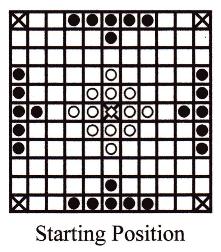 Board Design: A eleven by eleven square, for a total of 121 positions.
Board Design: A eleven by eleven square, for a total of 121 positions.
(Note: Other size boards are also used but the 11x11 board appears to be a very common size.)
The board represents the Throne Room of the king.
Each of the five royal spaces is marked with a large "X" inside the square, as follows:
- The king's throne is in the very center of the room and only the king (represented by the white diamond) may occupy the throne square.
- The four corners are royal exits and only the king may use them.
Objective: The king tries to escape to a corner exit. The dark soldiers try to surround the king.
How to Play:
The game board is always set up in the illustrated starting position, with the king (represented by the white diamond) sitting on his throne in the exact center of the throne room.
The dark soldiers move first. On future games the players should take turns being the dark soldiers.
The players take turns moving their pieces. A soldier or a king may be moved in a straight line any number of empty spaces forwards, backwards, right, or left. Diagonal moves are not permitted. A game piece may not jump another game piece.
Neither a dark or a white soldier may move onto one of the royal corner exits, or onto the throne in the center of the room. Only the king may occupy those squares. However, a white soldier and the white king may move in a straight line across the throne square if there is an empty square anywhere on the other side of the throne to land on. A dark soldier may not cross over the throne square but he must go around it and this will require move moves.
The objective is to capture one or more of your opponent's soldiers between two of your pieces in either a horizontal or vertical row, but not a diagonal row. Multiple captures on one move are allowed. When a soldier (or soldiers) is captured it is removed from the game board. Soldiers must be captured between game pieces of the other color, either by two soldiers or by the king working with one of his soldiers. Soldiers may also be trapped and captured between a royal exit and a soldier of the other color. A white soldier may not be captured between a dark soldier and the throne square, but a dark soldier can be captured between a white soldier and the throne square.
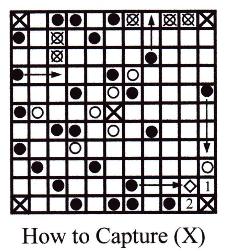 In the illustration, each white soldier with an "X" mark will be captured if the dark soldier moves into the position indicated by the arrow. The three white captures on the top edge of the board that are a result of the one dark move is an example of a multiple capture. If the king is part of a group of soldiers in a captured straight line, then only the soldiers are captured but the king is not.
In the illustration, each white soldier with an "X" mark will be captured if the dark soldier moves into the position indicated by the arrow. The three white captures on the top edge of the board that are a result of the one dark move is an example of a multiple capture. If the king is part of a group of soldiers in a captured straight line, then only the soldiers are captured but the king is not.
The king can be captured:
1. between four dark soldiers with one dark soldier on each side of the king, or
2. between three dark soldiers and the outside edge of the board, or
3. between three dark soldiers and the throne, or
4. between two dark soldiers and a royal exit.
In the illustration, if the king moves into space number 2, and the dark soldier to the left of the king then moves into the position originally held by the king, then the king would be captured with a dark soldier on two sides and a royal exit on the right.
However, if the king moves into space number 1, and the dark soldier to the left of the king then moves into the position originally held by the king, then the king would not be captured because a white soldier is above him. The king would be able to move onto the royal exit on his next move and win the game.
If the king moves into space number 1, and the dark soldier on the right edge of the board then moves straight down to the space above the white soldier, then the white soldier directly above space number 1 would be captured. But the king would not be captured and the king could then move onto the royal exit in the right corner on his next move and win the game.
If a dark soldier moves to where it could capture the king on its next move, then the dark player must say "Watch your king."
If the king moves into a position where he could move onto one of the royal exits on his next move then the white player must say, "Exit." If the king could move onto either one of two different royal exits on his next move, then the white player must say, "Double Exit."
The only way to capture an opponent's piece is when it is your move. You can safely move one of your pieces between two of your opponent's pieces and your piece will not be considered captured since it was your move.
Winning: There are two ways the game can be won:
1. The light color king can win by moving onto any one of the four royal corner exits.
2. The dark color soldiers can win by surrounding and capturing the king.
Go
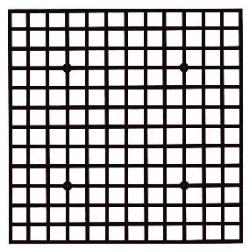 Name of Game: The game is known as Wei Ch’i or Weiqi in China, as Bakuk in Korea, and as Igo or Go in Japan.
Name of Game: The game is known as Wei Ch’i or Weiqi in China, as Bakuk in Korea, and as Igo or Go in Japan.
Origin of Game: China before 2258 B.C. - According to legend the Chinese Emperor Yao (2337-2258 B.C.) had the game designed for his son to teach him concentration, balance, and discipline. Although the game is easier to learn than chess, it is significantly more challenging than chess.
Players: 2
Beginner Board Design: Nine by nine square, with 41 black stones and 40 white stones.
Intermediate Board Design: Thirteen by thirteen square, with 85 black stones and 84 white stones.
Advanced Board Design: Nineteen by nineteen square, with 181 black stones and 180 white stones.
Objective: To surround and control as many intersections as possible, and to capture as many of the other player's stones as possible.
Definition of Game Words With Visual Examples:
Stone: The official name of a playing piece of either color.
Point: (See "P" below.) A vacant intersection of two lines, anywhere in the center of the board, or on the edges of the board, or at the corners of the board. A point beside a stone is called a liberty.
Liberty: (See "L" below.) A vacant point adjacent to a stone. A single stone by itself in the middle of the board will have four liberties.
Star Points: (See "S" below.) The dark circles at specific intersections where black stones may be placed before a game begins. This would give a less experienced player a better chance against a more experienced player. Star points may also become liberties during the game.
Capture: Occurs when a stone is surrounded by stones of the other color. All the white stones marked with an “X” in the illustration below are captured and they should be removed from the board. Captured stones are called prisoners.
Connection: Two stones that are adjacent to one another along a dark line on the board are said to be connected. Connected stones form a group or chain. Once connected into a group all the stones are treated as a group and they all share the same fate.
Group or Chain: (See "G" below.) Two or more stones of the same color that are adjacent to one another along any of the dark lines on the board. These adjacent stones are connected to one another into a group or chain.
Eye: (See "E" below.) An empty liberty surrounded on all sides by an unbroken group of continuous stones of the same color.
Atari: (See "A" below.) A stone surrounded by stones of the other color so that it only has one open liberty point.
Alive: (See "G1" and "G8" below.) Groups around one or two eyes.
Dead: At the end of the game, a stone or group of stones is "dead" if it is not part of a group that has surrounded one or two eyes. Any stones in Atari are considered "dead" the moment Atari occurs.
Unsettled or dual life: A rare end game situation. Neither side has any "eyes." However if they have some stones in groups that cannot be captured then those stones are not removed from the board.
Suicide: (See "U" below.) A player may not place a stone in a position where it would be immediately captured and removed from the board. For example, black could not put a stone at "U" because it would be immediately captured by white and removed from the board.
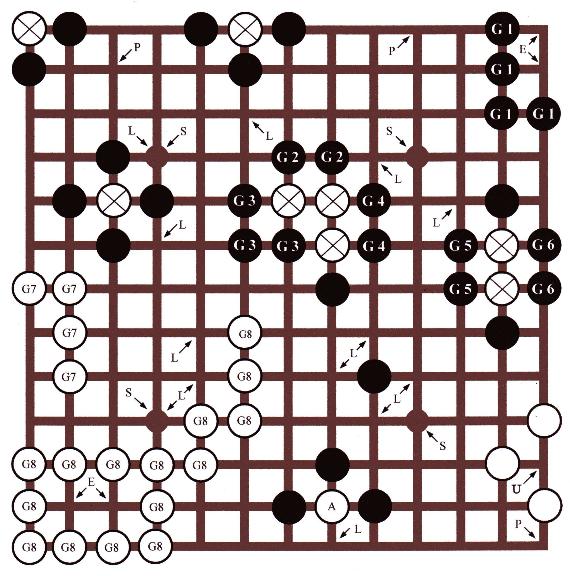
How to Play:
The game begins with an empty board. Black moves first. The game is played on the intersections of the lines and not on the square spaces between the lines.
If the playing skills are significantly different between the two players, then the less experienced player plays the black stones. He or she may also be allowed to place a black stone on each "Star Point" before the game begins. Then the game begins and White places a white stone on the board.
Players take turns placing one stone on any vacant intersection, which is called a point. After a stone has been placed on the board it cannot be moved, unless it is captured by the other player. Captured stones are not returned to the game board.
Adjacent stones of the same color along connecting dark lines on the board form a group (or chain) that share their liberties in common. The stones do not have to be in a straight line. Diagonal stones are not connected because there is no dark line between them.
A vacant intersection adjacent to a stone is called a liberty. Groups of stones share the same liberties. A group of stones must share or surround a minimum of one liberty to remain on the board. A group of stones that surrounds two liberties or eyes is permanently safe from capture.
If a chain is surrounded by stones of the other color so that it has no liberties, then those stones are captured and they are removed from the game board by the capturing player. The captured stones are called prisoners.
A player cannot place a stone on a point if doing so would result in that stone or group of stones being immediately captured. This is called suicide and it is prohibited. However, this move is allowed if the move immediately results in the capture of some of the other player's stones so that when those stones are removed from the board the original stone now has at least one liberty.
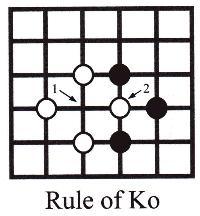 Rule of Ko:
Rule of Ko:
Ko means eternity. A player cannot place a stone that recreates the exact arrangement of the game board just before the other player's most recent move. This is called repetition and it is not permitted. In the example on the right, if Black places a stone at Point 1 then the White stone at Point 2 will be captured and removed from the board. If White then placed a new White stone at Point 2, the new Black stone at Point 1 would be captured and the game board would be returned to its previous starting position. Therefore, White is prohibited from placing a White stone at Point 2 on his or her very next move.
A stone cannot be captured if it was just used to capture another stone. The other player must make at least one other move and then the stone is eligible for capture on the player's following move.
End Game:
If a player sees no way to increase his or her territory, nor any way to capture one of the other player's stones, then the player may pass. The other player may then place a stone, and the first player then has the option to play again. However, if both players pass then the game is over. The game is also automatically over after the last stone has been placed on the board.
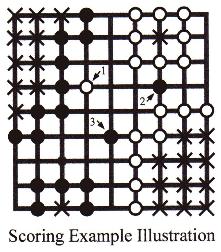 Winning:
Winning:
Prisoner Total: Remove all the "dead" stones from the board and add them to the prisoners captured by each player during the game. In the "Scoring Example Illustration" on the right, during the actual game Black captured 23 white stones, and White captured 25 black stones. On the game board on the right, Black has two dead stones at points 2 and 3 and those two stones should be removed from the board. White has one dead stone at point 1 and it should also be removed. Black's total White prisoners are now 23+1=24. White's total Black prisoners are now 25+2=27.
Alive Total: Count the number of remaining stones of each color on the board. This is each player's Alive Total. In the "Scoring Example Illustration" Black has 14 alive stones and White has 16 alive stones.
Enclosed Area Total: Count the number of empty points enclosed by each player's stones, including all the enclosed points between groups of stones and the edge of the board. This is each player's Enclosed Area Total. Counting the “X” marked points enclosed by each color shows that Black has 11 points and White has 12 points.
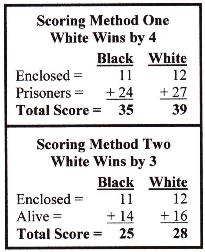 Final Scoring Method One: Add the Enclosed Area Total to the Prisoner Total for each player. Whichever player has the highest total wins. (Note: Alive stones are not counted in this scoring method.)
Final Scoring Method One: Add the Enclosed Area Total to the Prisoner Total for each player. Whichever player has the highest total wins. (Note: Alive stones are not counted in this scoring method.)
Final Scoring Method Two: Add the Enclosed Area Total to the Alive Total for each player. Whichever player has the highest total wins. (Note: Prisoners are not counted in this scoring method.)
Both Final Scoring Methods will yield a net difference in the total scores between the two players of zero or one. The reason is because the number of Alive stones a player has left on the board plus the number of Prisoners lost equals the total number of starting stones. Therefore either scoring method will almost always result in the same player being declared the winner of the game.
(Math Note: Total Stones Played = Alive Stones + Prisoner Stones.)
Pyramid Solitaire (Two Games)
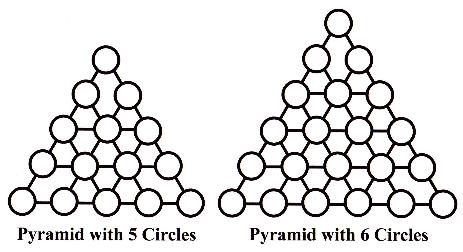 Name of Pyramid Game One: Pyramid Solitaire with Five Bottom Circles (Note: The Cracker Barrel Puzzle.)
Name of Pyramid Game One: Pyramid Solitaire with Five Bottom Circles (Note: The Cracker Barrel Puzzle.)
Name of Pyramid Game Two: Pyramid Solitaire with Six Bottom Circles
Origin of Games: Unknown
Players: One
Board Setup: A playing piece is placed on all the circles except one. The empty circle may be the top circle, or the middle circle in the third row, or the middle circle in the fifth row, or any other circle. A different starting position will require a new strategy to win.
Objective: Remove the game pieces until only one is left.
How to Play: A game piece is removed by jumping over it with an adjacent game piece along any of the straight lines on the board. Only one game piece can be jumped at a time and there must be an open circle on the other side of the piece being jumped for the jumping piece to land on. Jumped pieces are immediately removed from the game board.
End of Game: When no more jumps are possible, the game is over. Count the number of game pieces still on the game board to determine your score.
Final Score:
6 or more = You need more practice.
5 = Poor (Amateur Player).
4 = Below Average (Beginner Player).
3 = Average (Average Player).
2 = Very Good (Advanced Player).
1 = Excellent (Expert Player).
Square Solitaire
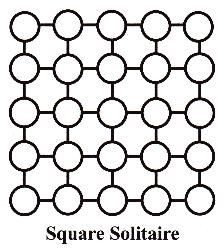 Name of Game: Square Solitaire
Name of Game: Square Solitaire
Origin of Game: Unknown
Players: One
Pieces: 24 pieces of any color.
Board Design: A five by five square.
Board Setup: A playing piece is placed on all the circles except one. The empty circle may be the middle circle in the second row, or the middle circle in the third row, or any other circle. A different starting position will require a new strategy to win.
Objective: Remove the game pieces until only one is left.
How to Play: A game piece is removed by jumping over it with an adjacent game piece along any of the straight lines on the board. Only one game piece can be jumped at a time and there must be an open circle on the other side of the piece being jumped for the jumping piece to land on. Jumped pieces are immediately removed from the game board.
End of Game: When no more jumps are possible, count the number of pieces still on the game board to determine your score.
Final Score:
6 or more = You need more practice.
5 = Poor (Amateur Player).
4 = Below Average (Beginner Player).
3 = Average (Average Player).
2 = Very Good (Advanced Player).
1 = Excellent (Expert Player).
Nine Men Solitaire
 Name of Game: Nine Men Solitaire
Name of Game: Nine Men Solitaire
Origin of Game: U.S.A. in early 1900's
Players: One
Pieces: 9 pieces of any color.
Board Design: A five by five square.
Board Setup: A playing piece is placed on each dark circle in the center of the board.
Objective: Remove the game pieces until only one is left in the center of the board.
How to Play: A game piece is removed by jumping over it with an adjacent game piece along any of the lines on the board. Only one game piece can be jumped at a time and there must be an open circle on the other side of the piece being jumped for the jumping piece to land on. Multiple jumps are allowed. Multiple jumps count as one move. Jumped pieces are removed from the game board.
End of Game: When no more jumps are possible, the game is over. If there is one game piece in the exact center of the game board, then you win.
How to Score: Count each move as you play the game. Your final score is your total number of moves. Try to beat your previous low score. Can you do it in four moves?
Hexagon Solitaire
 Name of Game: Hexagon Solitaire
Name of Game: Hexagon Solitaire
Origin of Game: Unknown
Players: One
Pieces: 36 pieces of any color.
Board Setup: A playing piece is placed on all the circles except the circle in the very center of the hexagon.
Objective: Remove the game pieces until only one is left.
How to Play: A piece is removed by jumping over it with an adjacent piece along any of the straight lines on the board. Only one piece can be jumped at a time and there must be an open circle on the other side of the piece being jumped for the jumping piece to land on. Multiple jumps are allowed. Multiple jumps count as one move. Jumped pieces are immediately removed from the game board.
End of Game: When no more jumps are possible, the game is over. Count the number of game pieces still on the game board to determine your score.
Final Score:
6 or more = You need more practice.
5 = Poor (Amateur Player).
4 = Below Average (Beginner Player).
3 = Average (Average Player).
2 = Very Good (Advanced Player).
1 = Excellent (Expert Player).
Two Color Swap Places Solitaire (Three Games)
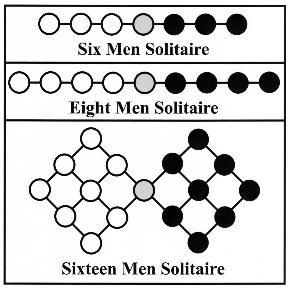 Origin of Six Men Solitaire: Also known as "Leap Frog." The puzzle was widely known in the early 1900's. (Note: Low Score = 15 Moves.)
Origin of Six Men Solitaire: Also known as "Leap Frog." The puzzle was widely known in the early 1900's. (Note: Low Score = 15 Moves.)
Origin of Eight Men Solitaire: Origin unknown.
Origin of Sixteen Men Solitaire: Also known as the "Sixteen Puzzle" and the "Fore and Aft Puzzle." It was invented by an English sailor during the 1800's.
Players: One
Pieces: Enough pieces of each of two colors to fill each half of the game board.
Board Setup: A playing piece of the correct color is placed on each colored circle except in the gray circle.
Objective: Move all the game pieces of each color from one side of the board to the other side.
How to Play: Pieces may move as follows:
- A piece may move to an adjacent empty circle along any of the straight lines on the board.
- A piece may jump one piece of any color if there is an open circle on the other side of the piece being jumped for the jumping piece to land on. Jumped pieces are not removed from the game board.
End of Game: When all the game pieces of each color have switched sides of the board, and the gray circle in the center is empty, the game is over.
How to Score: Count each move as you play the game. Your final score is the total number of moves you took to win the game. Try to beat your previous low score.
Square Four Corner Swap Places Solitaire
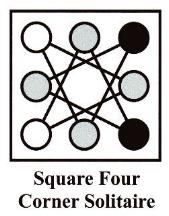 Name of Game: Square Four Corner Swap Places Solitaire
Name of Game: Square Four Corner Swap Places Solitaire
Origin of Game: 1800's
Players: One
Pieces: Two dark color pieces and two light color pieces.
Board Design: A square with eight circles around the outside. Each circle is connected to two other circles.
Board Setup: A playing piece of the correct color is placed on each colored circle except in the gray circles.
Objective: Swap the game pieces of each color to the colored circles on the opposite side of the board.
How to Play: A game piece may move to an empty circle to which it is linked by a straight line. A game piece may pass through an empty circle and continue to the next empty circle along the next straight line.
End of Game: When all the game pieces of each color have switched sides of the board, the game is over.
How to Score: Count each move as you play the game. Your final score is the total number of moves you took to win the game. Try to beat your previous low score. (Note: Can you do it in seven moves?)
Eight Point Star Swap Places Solitaire
 Name of Game: Eight Point Star Swap Places Solitaire
Name of Game: Eight Point Star Swap Places Solitaire
Origin of Game: Unknown
Players: One
Pieces: Three dark color pieces and three light color pieces.
Board Design: An eight point star with a circle in each star point. Each circle is connected to two other circles.
Board Setup: A playing piece of the correct color is placed on each colored circle except in the gray circles.
Objective: Swap the game pieces of each color to the colored circles of the other game pieces.
How to Play: A game piece may move to an empty circle to which it is linked by a straight line. A game piece may pass through an empty circle and continue to the next empty circle along the next straight line.
End of Game: When all the game pieces of each color have switched circles on the board, the game is over.
How to Score: Count each move as you play the game. Your final score is the total number of moves you took to win the game. Try to beat your previous low score.
English Solitaire
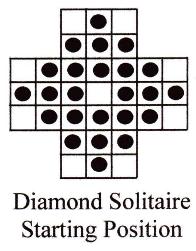
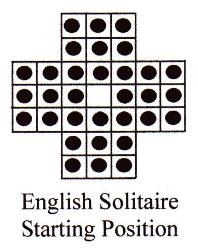 Name of Game: English Solitaire
Name of Game: English Solitaire
Origin of Game: Unknown
Players: One
Pieces: 32 pieces of any color.
Board Design: A seven by seven cross, for a total of thirty-three positions.
Board Setup: A playing piece is placed on every space on the board except in the exact center.
Objective: Remove the game pieces until only one is left.
How to Play:
A game piece is removed by jumping over it with an adjacent game piece. Only one game piece can be jumped at a time and there must be an open position on the other side of the piece being jumped for the jumping piece to land on. Pieces can be jumped horizontally or vertically, either forwards or backwards, or right or left. Diagonal jumps are not permitted. Jumped pieces are immediately removed from the game board.
End of Game: When no more jumps are possible, the game is over. Count the number of game pieces still on the game board to determine your score.
Final Score:
6 or more = You need some serious practice.
5 = Poor (Amateur Player).
4 = Below Average (Beginner Player).
3 = Average (Average Player).
2 = Very Good (Advanced Player).
1 = Excellent (Expert Player).
1 Piece in Center Space = Outstanding (Master Player).
Variation of the English Solitaire Game:
Name of Game: Diamond Solitaire
The game begins with only 24 game pieces instead of 32 as shown in the Diamond Starting Illustration.
All the other rules and the scoring are exactly the same.
French Solitaire
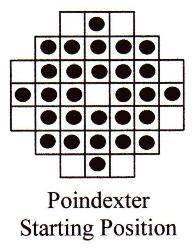
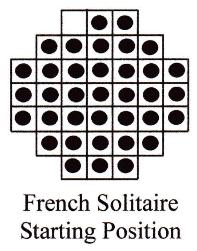 Name of Game: French Solitaire
Name of Game: French Solitaire
Origin of Game: Invented by a French prisoner while in the Bastille during the Seventeenth Century.
Players: One
Pieces: 36 pieces of any color.
Board Design: A seven by seven octagon, for a total of thirty-seven positions.
Board Setup: A playing piece is placed on every space on the board except in the top left corner.
Objective: Remove the game pieces until only one is left.
How to Play:
A game piece is removed by jumping over it with an adjacent game piece. Only one game piece can be jumped at a time and there must be an open position on the other side of the piece being jumped for the jumping piece to land on. Pieces can be jumped horizontally or vertically, either forwards or backwards, or right or left. Diagonal jumps are not permitted. Jumped pieces are immediately removed from the game board.
End of Game: When no more jumps are possible, the game is over. Count the number of game pieces still on the game board to determine your score.
Final Score:
6 or more = You need some serious practice.
5 = Poor (Amateur Player).
4 = Below Average (Beginner Player).
3 = Average (Average Player).
2 = Very Good (Advanced Player).
1 = Excellent (Expert Player).
1 Piece in Any Corner Space = Outstanding (Master Player).
Variation of the French Solitaire Game:
Name of Game: Poindexter
The game begins with only 28 game pieces instead of 36 as shown in the starting illustration.
All the other rules and the scoring are exactly the same.
All the above games, plus a lot more, are included in my book Ancient Board Games and Solitaire Games From Around the World, Combined Volumes One and Two.
Grandpappy's e-mail address is: RobertWayneAtkins@hotmail.com





































 Name of Game: Achi
Name of Game: Achi Name of Game: Horseshoe
Name of Game: Horseshoe
 Name of Game: Fox and Geese
Name of Game: Fox and Geese



 Winning: Whichever player takes the last game piece from the game board loses and the other player wins.
Winning: Whichever player takes the last game piece from the game board loses and the other player wins. Name of Game: Four Field Kono
Name of Game: Four Field Kono
 Name of Game: Mu Torere
Name of Game: Mu Torere Name of Game: El-Quirkat (Arabia), Alquerque (Spain)
Name of Game: El-Quirkat (Arabia), Alquerque (Spain) Name of Game: Seega
Name of Game: Seega Stage Two: Each player then takes a turn moving one of his or her pieces. A piece may be moved one space forwards, backwards, right, or left, but not diagonally. A piece may not jump another piece.
Stage Two: Each player then takes a turn moving one of his or her pieces. A piece may be moved one space forwards, backwards, right, or left, but not diagonally. A piece may not jump another piece. Name of Game: Derrah
Name of Game: Derrah Name of Game: Chinese Checkers
Name of Game: Chinese Checkers Name of Game: Checkers or Draughts
Name of Game: Checkers or Draughts
 Name of Game: Checker Solitaire: Either Square or Diamond.
Name of Game: Checker Solitaire: Either Square or Diamond. Name of Game: Diamond Chinese Checkers
Name of Game: Diamond Chinese Checkers Name of Game: Triangular Checkers
Name of Game: Triangular Checkers Name of Game: The Fox and the Hounds
Name of Game: The Fox and the Hounds
 Name of Game: Nine Men's Morris (Version One)
Name of Game: Nine Men's Morris (Version One) Name of Game: Gomoku
Name of Game: Gomoku Name of Game: Dai Hasami Shogi (Dai means “double,” Hasami means “sandwiching,” Shogi means “9 by 9 board.”)
Name of Game: Dai Hasami Shogi (Dai means “double,” Hasami means “sandwiching,” Shogi means “9 by 9 board.”) The starting position and the movement rules remain the same.
The starting position and the movement rules remain the same. Origin of Game: Ancient Greece, before 360 B.C. - Later called Single Stone Latrunculi by the Romans.
Origin of Game: Ancient Greece, before 360 B.C. - Later called Single Stone Latrunculi by the Romans. In the illustration, each white piece with an “X” mark has been captured and it should be removed from the game board. The white piece in the lower left corner of the board is now “trapped” and it cannot move. However, it was not “captured” so it remains on the game board. White could free the trapped piece by moving the white piece in the direction of the arrow and capturing the black piece.
In the illustration, each white piece with an “X” mark has been captured and it should be removed from the game board. The white piece in the lower left corner of the board is now “trapped” and it cannot move. However, it was not “captured” so it remains on the game board. White could free the trapped piece by moving the white piece in the direction of the arrow and capturing the black piece. Board Design: A twelve by eight rectangle, for a total of ninety-six positions.
Board Design: A twelve by eight rectangle, for a total of ninety-six positions. Winning: There are two ways a player can win the game:
Winning: There are two ways a player can win the game: Board Design: A twelve by eight rectangle, for a total of ninety-six positions.
Board Design: A twelve by eight rectangle, for a total of ninety-six positions. In the illustration, each white soldier with an “X” mark has been captured and it should be removed from the game board. If a king is part of a group of soldiers in a captured straight line, then only the soldiers are captured but the king is not, such as the white king in the row with two captured white soldiers.
In the illustration, each white soldier with an “X” mark has been captured and it should be removed from the game board. If a king is part of a group of soldiers in a captured straight line, then only the soldiers are captured but the king is not, such as the white king in the row with two captured white soldiers. Board Design: A eleven by eleven square, for a total of 121 positions.
Board Design: A eleven by eleven square, for a total of 121 positions. In the illustration, each white soldier with an "X" mark will be captured if the dark soldier moves into the position indicated by the arrow. The three white captures on the top edge of the board that are a result of the one dark move is an example of a multiple capture. If the king is part of a group of soldiers in a captured straight line, then only the soldiers are captured but the king is not.
In the illustration, each white soldier with an "X" mark will be captured if the dark soldier moves into the position indicated by the arrow. The three white captures on the top edge of the board that are a result of the one dark move is an example of a multiple capture. If the king is part of a group of soldiers in a captured straight line, then only the soldiers are captured but the king is not. Name of Game: The game is known as Wei Ch’i or Weiqi in China, as Bakuk in Korea, and as Igo or Go in Japan.
Name of Game: The game is known as Wei Ch’i or Weiqi in China, as Bakuk in Korea, and as Igo or Go in Japan.
 Rule of Ko:
Rule of Ko: Winning:
Winning: Final Scoring Method One: Add the Enclosed Area Total to the Prisoner Total for each player. Whichever player has the highest total wins. (Note: Alive stones are not counted in this scoring method.)
Final Scoring Method One: Add the Enclosed Area Total to the Prisoner Total for each player. Whichever player has the highest total wins. (Note: Alive stones are not counted in this scoring method.) Name of Pyramid Game One: Pyramid Solitaire with Five Bottom Circles (Note: The Cracker Barrel Puzzle.)
Name of Pyramid Game One: Pyramid Solitaire with Five Bottom Circles (Note: The Cracker Barrel Puzzle.) Name of Game: Square Solitaire
Name of Game: Square Solitaire Name of Game: Nine Men Solitaire
Name of Game: Nine Men Solitaire Name of Game: Hexagon Solitaire
Name of Game: Hexagon Solitaire Origin of Six Men Solitaire: Also known as "Leap Frog." The puzzle was widely known in the early 1900's. (Note: Low Score = 15 Moves.)
Origin of Six Men Solitaire: Also known as "Leap Frog." The puzzle was widely known in the early 1900's. (Note: Low Score = 15 Moves.) Name of Game: Square Four Corner Swap Places Solitaire
Name of Game: Square Four Corner Swap Places Solitaire Name of Game: Eight Point Star Swap Places Solitaire
Name of Game: Eight Point Star Swap Places Solitaire
 Name of Game: English Solitaire
Name of Game: English Solitaire
 Name of Game: French Solitaire
Name of Game: French Solitaire
